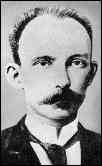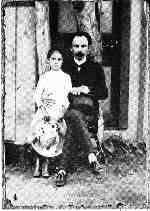
Is José Martí related to Cesar Romero?


When Martí arrived in New York on January 3 1880, he went to live in a boardinghouse owned and operated by Carmen (Carmita) Miyares de Mantilla at 51 East 29th Street, in Manhattan. The house was generally only open to known friends and Cuban exiles known to the revolutionists. Its speculated that Martí had met the Mantillas on his two previous trips to New York in October 1874 and January 1875.
Eleven months after Martí's arrival in New York, Carmita gave birth to María Mantilla (November 28 1880).
On January 6 1881, María was baptized at Saint Patrick Church in Brooklyn. Her mother was listed as Carmen Miyares de Mantilla, and her father as Manuel Mantilla. Martí was listed as her Godfather.
To this day, there are those who claim that María was not Martí's daughter, and others who point out that she was. They all agree that Martí loved María like a father. Less known is the fact that he raised and educated her, and referred to her as his daughter.
Gonzalo Quesada, Martí's official biographer, carefully avoids this question in most of his writings, as have most writers since. The maestro's private life has always been, respectfully, out of bounds, as if it might discredit or distract from his public accomplishments.
A careful examination of Martí's relationship to Carmen and María might, in fact, have the opposite effect, revealing not only that he was María's father, but also that she was the person he loved most in his short life, a role that he took very seriously.
Four years earlier, while still in Mexico before the end of Cuba's Ten-Year War, Martí married Carmen Zayas Bazán (December 20 1877). He was allowed to return to Cuba after the war ended, and they came to Havana on September 3 1878. Their son José "Pepito" Martí Zayas Bazán was born on November 12 of the same year.
As Marti's son celebrated his first birthday, the Little War broke out in Cuba, and Martí was accused of conspiring with the rebels (even though he did not support the war) and deported to Spain. He immediately left for New York and took residence at Carmita's boarding house.
Martí's wife, Carmen, did not like anything about life in New York, and stayed in Havana with their son. She visited her husband in New York three times over the next decade, but could only stay a few months at a time before returning to Cuba. Marti's son was raised to support Spanish rule of Cuba.
Whatever happened in the Mantilla household between Martí and Carmita has been carefully avoided in most historical texts.
Manuel Mantilla, Carmita's husband and father of her 3 earlier children, was a dying invalid, with no known hostility towards Martí. Manuel died in 1885.
As sad as Martí was to be away from his son, he was equally devoted to his daughter of New York, María, and her mother, Carmita.
Perhaps less known is the depth and passion of Martí's letters to María and Carmita in the two months before his death. In the book, LA NIÑA DE NEW YORK, UNA REVISIÓN DE LA VIDA ERÓTICA DE JOSÉ MARTÍ, José Miguel Oviedo asserts that Marti's letters to María may be the maestro's best writing in any genre.
From Cabo Haitiano, on his way to Cuba to join the war for independence, Martí writes to María, "when someone is nice to me, or nice to Cuba, I show them your picture. My wish is that you all live together, with your mother, and that you have a good life."
"Love your mother," he writes to her only weeks before his death in battle at Dos Rios. "I've never known a better woman in this world. I can't, nor will I ever, think of her without seeing how clear and beautiful life is. Take great care of this treasure."
Marti was also a father figure to Carmita's children from her deceased husband. He educated the girls himself, and encouraged them to become teachers (an acceptable position for a woman at the time) and speak various languages. "Wait for me," he wrote to María, "as long as you know that I'm alive."
In January 1905 María married César Romero in New York. They had 4 children, Maria Teresa, Graciela Eduardo and César, who was born February 15 1907. The boy, César Romero, became a well-known movie/TV personality remembered for numerous popular roles, including the original Joker in TV's Batman (1966-68).
Romero always claimed with pride that he was Martí's grandson. Disbelievers point out the immense physical differences between the two men; Martí was short and thin, not very athletic by nature. Romero was tall (6' 2") and muscular. However, disbelievers fail to consider how much Romero's mother, María, looked like Martí.
César Romero died on 1/1/1994 in Santa Monica, California. He has two stars on the Hollywood Walk of Fame, at 6615 Hollywood Blvd. and 1719 Vine Street.

Photo: Martí and María, who was 10 years old, on a trip to Bath Beach in 1890
You can learn about Romero on the Internet Movie Database (http://imdb.com/name/nm0003110/).
Photo at right:
Martí and
María,
who was 10 years old,
on a trip to Bath Beach in
1890.
Related:
José Martí Portal |
José Martí
Timeline |
Books About Martí |
Photos of Martí from
Independence Gallery
Front Door | Contents | Galleries | Index | Timetables